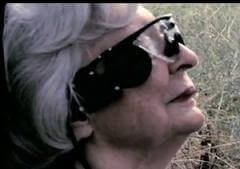
Modern science is mimicking the miraculous by restoring sight to the blind. The Argus line of artificial retinas has been able to give a primitive (low resolution) vision to patients with retinitis pigmentosa for years now. An external camera transmits images to an electrode array implanted directly on the patient’s retina. We’ve been consistently impressed by the capabilities of these implants which were developed for the US Department of Energy’s Artificial Retina Project. Now, as the third phase of development (Argus III) is gearing up, we’d thought it be a great time to look at some of the amazing accomplishments of this project. We’ve got some awesome videos of patients using the Argus I and Argus II below, as well as a truly moving clip from National Geographic. Enjoy.
Linda Morford was interviewed by Britain’s SkyNews back in 2008. Fitted with a 16 pixel array (Argus I), she was able to regain enough vision to walk through and interact with her environment. Interviewer Thomas Moore gives a great overview of the Argus technology starting at 0:45.
Kathleen Blake’s interview on Nightly News in 2009 highlights her personal experience with the Argus II and its ~60 pixel array. She gives great insight into what it means to be one of the few people on the planet to have their vision restored with such a device:
JoAnn Lewis was the 17th person to be fitted with an Argus (one of the mark II series), and she was already 79 when it happened. Instead of giving us a technical look at the artificial retina, National Geographic took a much more visceral approach. Fair warning, the following video contains graphic depictions of eye surgery. It does a great job of conveying the sense of vision loss and restoration:
Every iteration of the Argus is improving the resolution of the device from 4 pixels to 16 to 60, and the Argus III will have hundreds, perhaps even more than a thousand. This means that every generation is taking another step towards restoring sight that would allow a blind person to operate without a cane or guide. Other technologies have even better resolution (Brainport is already above 1000 points of information) but the Argus system works in a way that most closely resemble natural use of the eyes. In the years to come, prosthetics of all kinds are set to improve, and it may only take a few more iterations before these devices are in fact superior to our natural organs. I look forward to the day when technology cannot only restore sight to the blind, but give a new range of vision to everyone.
[image credit]
[source: DOE, Second Sight]


